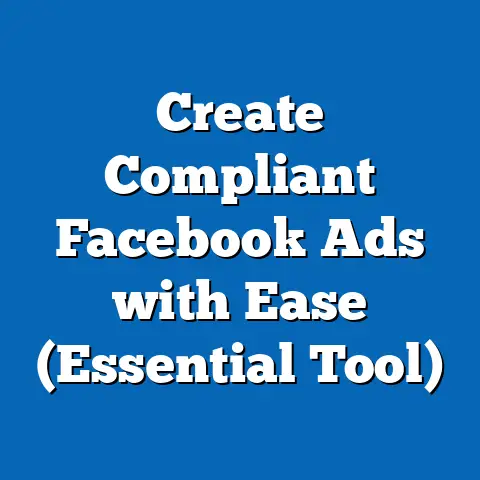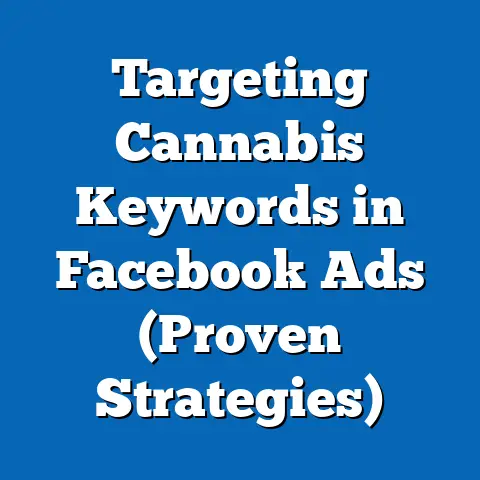Unlock Geofencing Ads on Facebook (Expert Strategies)
Have you ever walked past a coffee shop and suddenly seen an ad for a discounted latte pop up on your phone? Or perhaps you were near a competitor’s store and noticed an advertisement for a similar product at a lower price? This isn’t magic; it’s the power of geofencing ads at work.
In today’s digital marketing arena, geofencing ads are becoming increasingly vital, offering businesses a unique opportunity to target potential customers with pinpoint accuracy based on their real-time location. With the explosion of mobile usage and the rise of location-based marketing, understanding and implementing geofencing strategies on platforms like Facebook can be a game-changer for businesses looking to drive foot traffic, boost local sales, and connect with their audience on a more personal level.
I’ve seen firsthand how incredibly effective geofencing can be. I once worked with a local bakery that was struggling to attract customers during the slower mid-afternoon hours. By implementing a geofencing campaign targeting people within a half-mile radius offering a “sweet treat” discount, we saw a significant increase in foot traffic and sales during those previously quiet periods. It was a testament to the power of reaching the right people, in the right place, at the right time.
Understanding Geofencing Ads
What are Geofencing Ads?
Geofencing ads are a type of location-based advertising that uses virtual boundaries, or “geofences,” to target potential customers who are within a specific geographic area. When a user enters a defined geofence, their mobile device can trigger an ad to be displayed on their Facebook feed or other platforms.
Think of it like this: you draw a digital circle (or any shape!) around a location – a store, a competitor’s premises, an event venue – and when someone with Facebook installed on their phone enters that area, they become eligible to see your ad.
This technology offers a level of precision that traditional advertising methods simply can’t match. Instead of casting a wide net, you can focus your efforts on reaching the people who are most likely to be interested in your products or services because they are already physically present in a relevant location.
The Technology Behind Geofencing
The magic of geofencing relies on a combination of technologies:
- GPS (Global Positioning System): This is the most common method, using satellite signals to pinpoint a device’s location with a high degree of accuracy.
- Wi-Fi: By triangulating the signals from nearby Wi-Fi networks, geofencing can determine a device’s location even indoors.
- Mobile Data: Similar to Wi-Fi triangulation, mobile data signals can also be used to estimate a device’s location, although this method is generally less accurate than GPS or Wi-Fi.
Facebook leverages these technologies to determine when a user enters a geofenced area, triggering the display of relevant ads. It’s important to note that users must have location services enabled on their devices and have granted Facebook permission to access their location for geofencing to work effectively.
Benefits of Geofencing Ads on Facebook
Geofencing ads offer a plethora of benefits for businesses looking to boost their local marketing efforts:
- Increased Relevance: By targeting users based on their real-time location, you can deliver ads that are highly relevant to their immediate needs and interests. This increased relevance leads to higher engagement rates and improved conversion rates.
- Enhanced Engagement: Geofencing ads can be used to drive foot traffic to physical stores, promote local events, or offer time-sensitive promotions to nearby customers. This creates a sense of urgency and encourages immediate action.
- Improved Conversion Rates: By targeting users who are already in a buying mindset (e.g., those near a competitor’s store), you can significantly increase your chances of converting them into paying customers.
- Cost-Effectiveness: Geofencing ads allow you to focus your advertising spend on the people who are most likely to be interested in your products or services, reducing wasted impressions and maximizing your ROI.
- Competitive Advantage: By targeting users near your competitors’ locations, you can steal market share and attract new customers who may be looking for alternative options.
Takeaway: Geofencing ads on Facebook are a powerful tool for reaching local audiences with relevant, timely, and engaging messages. Understanding the technology behind geofencing and the benefits it offers is crucial for creating successful location-based marketing campaigns.
Setting Up Geofencing Ads on Facebook
Now that you understand the power of geofencing ads, let’s dive into the practical steps of setting them up on Facebook.
Step-by-Step Guide
-
Access Facebook Ads Manager: The first step is to log in to your Facebook account and navigate to the Ads Manager. You can find it in the left-hand menu or by searching for “Ads Manager” in the search bar.
-
Create a New Campaign: Once you’re in Ads Manager, click on the “+ Create” button to start a new campaign.
-
Choose Your Campaign Objective: Facebook offers a variety of campaign objectives, such as “Awareness,” “Traffic,” “Engagement,” “Leads,” “App Promotion,” and “Sales.” For geofencing ads, the most relevant objectives are typically “Traffic” (to drive foot traffic to your store), “Engagement” (to promote a local event), or “Sales” (to drive online or offline sales). I usually go with Traffic or Sales, depending on the client’s goals.
-
Define Your Target Audience: This is where the magic of geofencing comes in. In the “Audience” section, you’ll find the “Location” targeting option. Here, you can specify the geographic area you want to target.
-
Set Up Your Geofence: You have several options for defining your geofence:
- Address: You can enter a specific address and define a radius around it (e.g., 1 mile, 5 miles, 10 miles). This is ideal for targeting users near your store or a specific landmark.
- Drop a Pin: You can manually drop a pin on a map to define the center of your geofence. This allows you to target specific areas that may not have a clear address.
- Bulk Locations: You can upload a CSV file with a list of addresses to create multiple geofences at once. This is useful for businesses with multiple locations.
Important Note: Facebook has minimum radius requirements for geofencing. The minimum radius is typically around 1 mile (1.6 kilometers).
-
Choose Your Ad Placements: Facebook allows you to choose where your ads will be displayed, such as Facebook News Feed, Instagram Feed, Audience Network, and Messenger. For geofencing ads, the most effective placements are typically Facebook News Feed and Instagram Feed, as these are the most visible and engaging platforms.
-
Set Your Budget and Schedule: Determine how much you want to spend on your campaign and when you want it to run. You can choose a daily budget or a lifetime budget, and you can set a specific start and end date for your campaign.
-
Create Your Ad: Design your ad with compelling copy, eye-catching visuals, and a clear call-to-action. Make sure your ad is relevant to the location you’re targeting and the audience you’re trying to reach.
-
Review and Publish: Before publishing your campaign, double-check all your settings to ensure everything is correct. Once you’re satisfied, click on the “Publish” button to launch your geofencing ads.
Access Facebook Ads Manager: The first step is to log in to your Facebook account and navigate to the Ads Manager. You can find it in the left-hand menu or by searching for “Ads Manager” in the search bar.
Create a New Campaign: Once you’re in Ads Manager, click on the “+ Create” button to start a new campaign.
Choose Your Campaign Objective: Facebook offers a variety of campaign objectives, such as “Awareness,” “Traffic,” “Engagement,” “Leads,” “App Promotion,” and “Sales.” For geofencing ads, the most relevant objectives are typically “Traffic” (to drive foot traffic to your store), “Engagement” (to promote a local event), or “Sales” (to drive online or offline sales). I usually go with Traffic or Sales, depending on the client’s goals.
Define Your Target Audience: This is where the magic of geofencing comes in. In the “Audience” section, you’ll find the “Location” targeting option. Here, you can specify the geographic area you want to target.
Set Up Your Geofence: You have several options for defining your geofence:
- Address: You can enter a specific address and define a radius around it (e.g., 1 mile, 5 miles, 10 miles). This is ideal for targeting users near your store or a specific landmark.
- Drop a Pin: You can manually drop a pin on a map to define the center of your geofence. This allows you to target specific areas that may not have a clear address.
- Bulk Locations: You can upload a CSV file with a list of addresses to create multiple geofences at once. This is useful for businesses with multiple locations.
Important Note: Facebook has minimum radius requirements for geofencing. The minimum radius is typically around 1 mile (1.6 kilometers).
Choose Your Ad Placements: Facebook allows you to choose where your ads will be displayed, such as Facebook News Feed, Instagram Feed, Audience Network, and Messenger. For geofencing ads, the most effective placements are typically Facebook News Feed and Instagram Feed, as these are the most visible and engaging platforms.
Set Your Budget and Schedule: Determine how much you want to spend on your campaign and when you want it to run. You can choose a daily budget or a lifetime budget, and you can set a specific start and end date for your campaign.
Create Your Ad: Design your ad with compelling copy, eye-catching visuals, and a clear call-to-action. Make sure your ad is relevant to the location you’re targeting and the audience you’re trying to reach.
Review and Publish: Before publishing your campaign, double-check all your settings to ensure everything is correct. Once you’re satisfied, click on the “Publish” button to launch your geofencing ads.
Tips for Choosing Effective Locations
Choosing the right locations for your geofences is crucial for the success of your campaign. Here are a few tips to keep in mind:
- High-Traffic Areas: Target areas with high foot traffic, such as shopping malls, tourist attractions, and public transportation hubs.
- Competitor Locations: Target users near your competitors’ stores to steal market share and attract new customers.
- Event Venues: Target users attending local events, such as concerts, festivals, and conferences, to promote your products or services.
- Residential Areas: Target users in residential areas near your store to drive local sales and build brand awareness.
- Consider Demographics: Think about the demographics of the people who frequent different locations. Are they your target audience?
Takeaway: Setting up geofencing ads on Facebook is a straightforward process, but it requires careful planning and attention to detail. By following the steps outlined above and choosing effective locations, you can create highly targeted campaigns that drive foot traffic, boost local sales, and connect with your audience on a more personal level.
Crafting Compelling Ad Content
While the location targeting of geofencing ads is crucial, the content of your ads is equally important. You need to create ads that resonate with local audiences and encourage them to take action.
The Significance of Targeted Ad Content
Generic ad content simply won’t cut it when you’re targeting users based on their location. Your ads need to be tailored to the specific needs, interests, and cultural nuances of the local community.
Think about it: someone walking down the street in New York City is going to have different expectations and preferences than someone walking down the street in a small town in Iowa. Your ads need to reflect those differences.
Strategies for Writing Compelling Copy
- Use Local Vernacular and Cultural References: Incorporate local slang, idioms, and cultural references into your ad copy to make it more relatable and engaging. This shows that you understand the local community and are not just another faceless corporation.
- Incorporate Time-Sensitive Offers and Promotions: Create a sense of urgency by offering time-sensitive discounts, promotions, or exclusive deals to nearby customers. This encourages immediate action and drives foot traffic to your store. For example, “Show this ad at our store within the next hour and get 20% off your purchase!”
- Highlight Local Events and Partnerships: Promote local events, festivals, or partnerships in your ads to show your support for the community and attract local customers.
- Address Local Pain Points: Identify the common problems or challenges faced by local residents and address them in your ad copy. This shows that you care about the community and are offering solutions to their needs. For example, if parking is a major issue in the area, you could highlight that your store offers free parking.
Utilizing Eye-Catching Visuals
- Reflect the Local Area or Community: Use images or videos that showcase the local area, landmarks, or community events. This helps to create a sense of connection and familiarity.
- Showcase Local Customers: Feature local customers in your ads to make them more relatable and authentic. This shows that your products or services are popular within the community.
- Use High-Quality Images and Videos: Make sure your visuals are high-quality and visually appealing. Blurry or pixelated images can detract from your message and make your ads look unprofessional.
- Consider Mobile Optimization: Optimize your visuals for mobile devices, as most users will be seeing your ads on their smartphones.
A/B Testing
A/B testing involves creating multiple versions of your ad with slight variations in the copy, visuals, or call-to-action, and then testing them against each other to see which performs best.
By A/B testing your geofencing ads, you can identify the elements that resonate most with local audiences and optimize your campaigns for maximum effectiveness.
Takeaway: Crafting compelling ad content is essential for the success of your geofencing campaigns. By tailoring your copy and visuals to the specific needs, interests, and cultural nuances of the local community, you can create ads that resonate with your audience and drive results.
Monitoring and Optimizing Geofencing Campaigns
Creating a geofencing campaign is just the first step. To truly maximize your ROI, you need to actively monitor its performance and make adjustments based on the data you collect.
The Importance of Tracking Performance
Tracking the performance of your geofencing ads allows you to understand what’s working and what’s not. This information is crucial for optimizing your campaigns and ensuring you’re getting the most bang for your buck.
Without tracking, you’re essentially flying blind. You won’t know if your ads are reaching the right people, if your copy is compelling, or if your call-to-action is effective.
Key Metrics to Monitor
- Impressions: The number of times your ad is displayed to users within your geofence. This metric tells you how many people are seeing your ad.
- Reach: The number of unique users who have seen your ad. This metric tells you how many different people you’re reaching.
- Click-Through Rate (CTR): The percentage of users who click on your ad after seeing it. This metric tells you how engaging your ad is.
- Conversion Rate: The percentage of users who take a desired action (e.g., make a purchase, fill out a form, visit your store) after clicking on your ad. This metric tells you how effective your ad is at driving results.
- Cost Per Click (CPC): The average cost you pay each time someone clicks on your ad. This metric tells you how efficient your ad spend is.
- Cost Per Conversion (CPC): The average cost you pay for each conversion. This metric tells you how much it’s costing you to acquire a new customer or achieve a desired outcome.
- Foot Traffic Data: If you’re using geofencing to drive foot traffic to your store, track the number of people who visit your store after seeing your ad. This can be done using tools like Google Analytics or by tracking in-store redemptions of coupons or promotions.
Tools and Techniques for Optimization
- Adjust Geofence Sizes: Experiment with different geofence sizes to see what works best for your business. A smaller geofence may be more targeted, but it may also limit your reach. A larger geofence may reach more people, but it may also include users who are not as likely to be interested in your products or services.
- Target New Locations: Based on your performance data, identify new locations that may be worth targeting. For example, if you’re seeing a lot of conversions from users near a specific competitor’s store, you may want to expand your geofence to include other nearby locations.
- Refine Ad Content: Continuously test and refine your ad copy, visuals, and call-to-action to see what resonates best with your target audience. Use A/B testing to compare different ad variations and identify the elements that are driving the most results.
- Optimize Ad Placements: Experiment with different ad placements to see which platforms are driving the most conversions. For example, you may find that your ads perform better on Facebook News Feed than on Instagram Feed.
- Adjust Bids: Monitor your CPC and CPA and adjust your bids accordingly. If you’re seeing a high CPC or CPA, you may need to lower your bids to improve your ROI. If you’re seeing a low CPC or CPA, you may be able to increase your bids to reach more people.
Takeaway: Monitoring and optimizing your geofencing campaigns is an ongoing process. By tracking your performance data, experimenting with different strategies, and making adjustments based on the results, you can continuously improve your ROI and achieve your marketing goals.
Real-World Case Studies and Success Stories
To illustrate the power of geofencing ads on Facebook, let’s take a look at a couple of real-world case studies:
Case Study 1: Local Coffee Shop
A local coffee shop in a busy downtown area was struggling to compete with larger chains. They implemented a geofencing campaign targeting people within a 0.5-mile radius offering a free pastry with the purchase of a coffee.
- Strategy: Targeted nearby office workers and residents during the morning rush and afternoon slump.
- Challenges: Standing out from the numerous other coffee shops in the area.
- Results: A 20% increase in foot traffic during the campaign period, and a significant boost in revenue.
Case Study 2: Retail Clothing Store
A retail clothing store wanted to promote a weekend sale to local shoppers. They set up a geofence around the shopping mall where their store was located, targeting people who were already in a shopping mindset.
- Strategy: Targeted shoppers at the mall with ads showcasing the sale items and offering a special discount for showing the ad at the register.
- Challenges: Attracting shoppers away from other stores in the mall.
- Results: A 15% increase in sales during the weekend sale, and a significant increase in brand awareness among local shoppers.
Valuable Lessons and Insights
- Relevance is Key: Both of these case studies highlight the importance of creating ads that are highly relevant to the location and the audience you’re targeting.
- Time-Sensitive Offers Work: Offering time-sensitive discounts or promotions can create a sense of urgency and encourage immediate action.
- Track Your Results: Monitoring your campaign performance and making adjustments based on the data is crucial for maximizing your ROI.
Takeaway: These case studies demonstrate the potential of geofencing ads to drive foot traffic, boost sales, and increase brand awareness for local businesses. By learning from these success stories and applying the strategies outlined in this guide, you can create your own winning geofencing campaigns.
We’ve covered:
- What geofencing ads are and how they work.
- The benefits of using geofencing ads on Facebook.
- A step-by-step guide for setting up geofencing ads.
- Strategies for crafting compelling ad content.
- The importance of monitoring and optimizing your campaigns.
- Real-world case studies and success stories.
Geofencing ads on Facebook offer a powerful tool for local businesses looking to increase their reach, drive sales, and connect with their audience on a more personal level. By leveraging the power of location-based marketing, you can target potential customers with pinpoint accuracy and deliver ads that are highly relevant to their immediate needs and interests.
In today’s competitive market, it’s more important than ever to stay ahead of the curve. Geofencing ads are a proven strategy for doing just that.
Call to Action: I encourage you to consider integrating geofencing into your marketing strategy to stay competitive in a location-driven market. Start experimenting with different geofence sizes, ad content, and targeting options to see what works best for your business. Track your results, optimize your campaigns, and watch your local marketing efforts soar!





